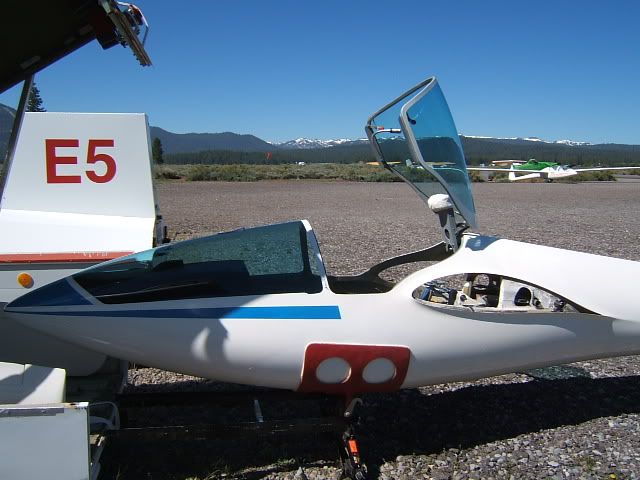I have some chicken feet and "crazing" on the fuselage of my glider. There are also a few places where paint is chipped from assembly/disassembly.
The ship was manufactured in the 1970s using a mold. Clearcoat was applied to the mold, then painted and fiberglass went in after that. It's the same process as a boat.
In the 1980s a guy built new wings and cut the fuselage off just ahead of the wings and made a new nose that is slicker, lower canopy (less drag) and a more reclined seating position.
Here's the question: Can I sand the hull, add some kind of materiel into the cracks and fair the thing making it smoother, free of ripples and just prettier? Can I inject resin into the fussures? Or is it more involved that that?
I plan on painting it with poly paint, probably the same scheme as seen below. In Europe they are required to paint the rudder and the leading edge of the wing with International Orange, after flying for a while I see the logic in that.

Well, I dunno nothin' 'bout no aero-plains, but in Lotus circles, it is generally accepted that the only way to fix spiderweb cracks so that they will not come back is to sand down the entire area of the crack, then add mat over the ground down area and sand the whole thing smooth. Some people with Europas have been experimenting with adding a super-glue type adhesive, particularly one that penetrates, to the cracks, grinding the cracks themselves out with a dremel tool and filling it in. I think the jury is out on if that fixes them permanently, versus the sand down the whole area and add a patch.
Note that the resin adds virtually no strength. It's the fiber that does. The resin just holds the fibers in place. Also, you should use the same type of material that the plane is made out of. So, if it was made with epoxy resin, you need to use epoxy in your repairs. Also, if it is all mat, use mat to repair it.
It really requires exploratory sanding to determine the depth of the damage. If it's limited to the gel coat, you'll need to take the gel down to the laminate, and build it back up. If you're really doing it right, sand all the finish off the nose, maybe laminate some very light cloth over the whole thing, knock that back w/ 180 grit in a random orbit, fair it w/ glazing putty, guide coat and block it, prime and paint.
You need to talk with an A&P. The FAA frowns upon some things. Find out how to do it safely and how not to get into hot water with the feds. Remember, the fiberglass is load bearing. I wouldn't risk it without asking.
Appleseed wrote:
You need to talk with an A&P. The FAA frowns upon some things. Find out how to do it safely and how not to get into hot water with the feds. Remember, the fiberglass is load bearing. I wouldn't risk it without asking.
Yeah. You wouldn't believe the paperwork required for composites repair I saw Delta submit to the FAA. Reams for sanding down an oil-soaked layer and replacing it with some fresh pre-preg, which is a very standard procedure for engine cowls.
There is definitely a correct way to do this. I won't touch this one with a 10 ft pole. OP needs to get in touch with the people (FAA Composites Maintenance Certificate Holders) that will answer all his questions. Unfortunately it will cost more money than some S-Glass, a DA, and epoxy resin, but you're messin' with a modified critical airframe structure.
He's on vacation, I was going to ask. There's also a before and after weight and balance requirement.
I was hoping it would be just "kiss it with glazing compound, buff it out". Thanks guys.































